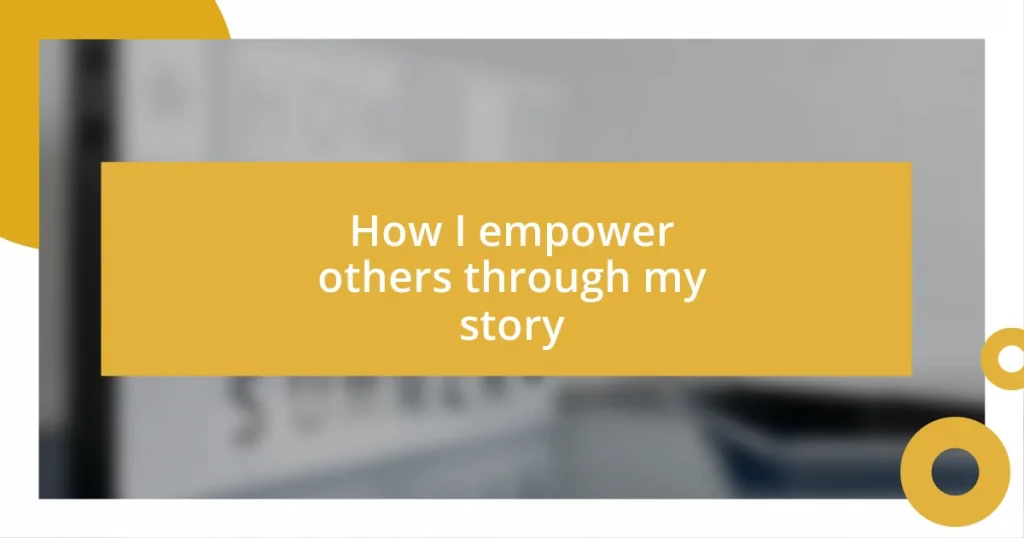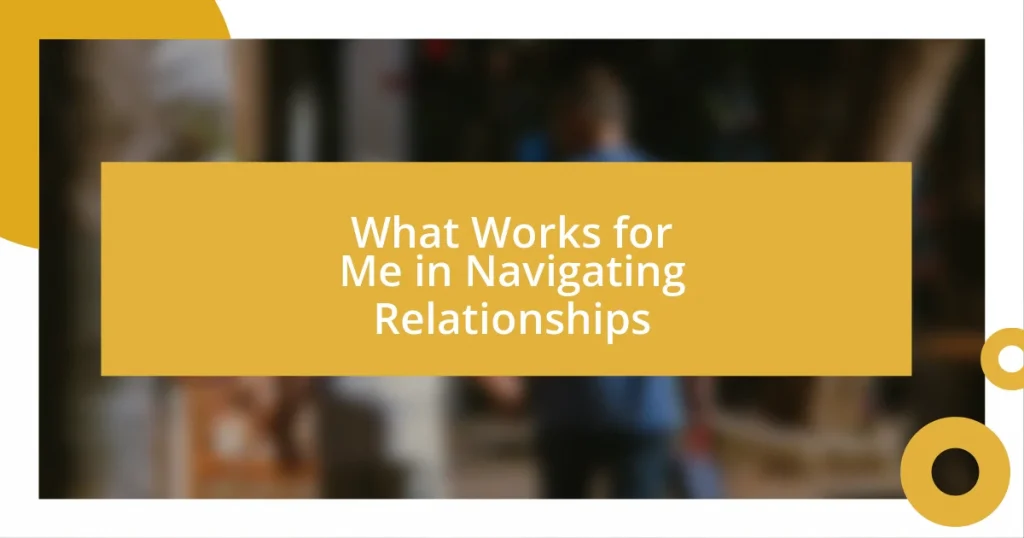Key takeaways:
- Storytelling fosters connection and empathy, allowing individuals to share vulnerable experiences that resonate with others.
- Identifying key life experiences through introspection reveals valuable lessons that can enhance personal narratives and offer insights to others.
- Building a supportive community is achieved through mutual sharing and encouragement, making individuals feel valued and fostering collective strength.

Understanding the power of storytelling
Storytelling wields incredible power, transcending mere entertainment to become a tool for connection and understanding. I still remember the first time I shared a vulnerable moment from my past with a group of strangers. Their reactions, filled with empathy, made me realize how a simple story could bridge the gap between different lives and experiences. Have you ever felt an unexplainable bond with someone simply because their story resonated with yours?
At its core, storytelling allows us to put a face to abstract ideas. I recall reading a memoir about someone overcoming adversity, and it struck a chord with me. It wasn’t just a recounting of events; it invited me into the author’s world, helping me see life through their eyes. This experience deepened my appreciation for resilience and prompted me to reflect on my own challenges. Has a story ever prompted you to reconsider your own perspective?
When we share our stories, we unlock a profound potential for empathy. I’ve observed how a personal narrative can evoke a spectrum of emotions, creating a safe space for others to share their own experiences in return. It’s like initiating a ripple effect of vulnerability. As we exchange stories, we foster connections that make us feel less alone. Isn’t that a beautiful aspect of humanity?

Identifying your key life experiences
Identifying your key life experiences involves introspection and honesty. I often find that the most significant moments in my life aren’t defined by their scale, but rather by the lessons they taught me. For instance, there was a time when I doubted my abilities as a leader. I recall a project that failed spectacularly, which initially felt like a setback. Yet, this moment became a potent lesson in resilience and helped me connect with others facing similar struggles. What moments have shaped your perspective in ways you didn’t expect?
As I sift through my memories, some key experiences stand out more than others. A chance encounter with a mentor during a tough time opened doors I never envisioned. This interaction highlighted the impact that kindness and support can have during our darkest days. It’s fascinating how sometimes, it’s the smallest actions that can lead to our greatest transformations. Can you identify a seemingly minor moment that shifted your life trajectory?
To truly identify these experiences, I encourage you to reflect on the emotions tied to them. How did you feel at the time? What realizations came from those situations? When I think about the times I stood on the edge of fear but chose to leap anyway, I recognize the pattern of growth that emerged. Understanding these emotions helps in pinpointing experiences that resonate deeply. Often, I’ve found that those key experiences are just waiting to be uncovered in our reflections.
| Experience Type | Emotional Insight |
|---|---|
| Failure | Resilience and Growth |
| Mentorship | Support and Transformation |
| A Moment of Courage | Empowerment and Confidence |

Crafting your personal narrative
Crafting your personal narrative is an intimate journey where authenticity plays a crucial role. I remember sitting down with a blank page, striving to articulate my story’s essence. It dawned on me that the most powerful narratives come from being genuine and raw. I poured my heart into recounting moments of struggle and triumph, realizing that vulnerability resonates deeply with others. What parts of your story do you hesitate to share, and how might they transform your narrative?
To create a compelling personal narrative, consider these key elements:
- Clarity of Purpose: Define why you’re sharing your story. Is it to inspire, educate, or connect?
- Emotional Depth: Don’t shy away from the feelings tied to your experiences. This is where connection happens.
- Engaging Details: Use vivid imagery and specific anecdotes that bring your experiences to life for the reader.
- Relatable Themes: Identify universal themes in your story that others can relate to, like fear, love, or growth.
- Reflection: Take a step back to evaluate your narrative. What lessons have emerged? This insight can add tremendous value.
By weaving together these elements, you can forge connections that resonate with readers on a profound level. Sharing my own journey, I’ve often found that the stories I was reluctant to tell became the most impactful, carving pathways for understanding and empathy. Have you discovered moments in your life that, once revealed, create a spark for others?

Connecting with your audience emotionally
Connecting with your audience emotionally is all about vulnerability and resonance. There was a time I stood before a crowd, nervous and unsure, sharing my story of overcoming self-doubt. As I spoke about those sleepless nights and relentless questioning, I saw heads nodding and eyes welling up. It struck me then how our shared struggles bridge gaps, allowing us to connect on a level that mere facts or achievements never could. Have you ever felt this connection when someone bared their soul?
One powerful moment that sticks with me is when I recounted losing a close friend. I didn’t just share the sadness; I painted a vivid picture of that day—the sun shining despite the heaviness in my heart. The audience leaned in, captivated not just by my words, but by their own memories surfacing. This interplay of emotions drives home the point that our experiences can spark feelings in others that lead to deep, meaningful conversations. What experiences of yours resonate with others in unexpected ways?
I’ve learned that emotions can be contagious. When I spoke about vulnerability, I noticed some audience members reflect on their own moments of fear and uncertainty. This shared emotional journey creates an invisible thread, binding us together. It’s amazing how allowing ourselves to be open and honest about our challenges can encourage others to do the same. What stories from your life are waiting to create that same bond?

Sharing your story authentically
Sharing your story authentically begins with embracing your true self. I recall a moment when I hesitated to express my feelings during a particularly challenging chapter of my life. As I started to write, my emotions spilled onto the page—fear, joy, and even confusion intertwined. This authenticity wasn’t just liberating for me; it also resonated with those who read it. Have you ever felt a similar release when you shared something deeply personal?
I’ve found that every detail counts when it comes to authenticity. For instance, while recounting my first experience with failure, I chose to describe the moments before I stepped onto the stage—the queasy feeling in my stomach, the buzzing lights, and the gentle encouragement from a friend. This tiny snapshot pulled readers in, creating a vivid image that allowed them to feel my anxiety and triumph. What details from your life could paint a richer picture of your own experiences?
Speaking from the heart often invites others to share their truths. One time, after sharing my struggles with imposter syndrome, a stranger approached me and said my words mirrored her own battles. It was then I realized how powerful authenticity is; it not only freed me but also inspired her to talk about her challenges. Have you welcomed someone else’s story simply because yours was shared first? When we allow ourselves to be real, we open the door for others to explore their own journeys, fostering a community of shared experiences.

Building a supportive community
Building a supportive community comes down to creating spaces where people feel valued and understood. I remember organizing a small gathering where everyone was encouraged to share their stories. As one participant recounted her journey through grief, I noticed the way the group leaned in, offering nods and whispered affirmations. This simple act of listening fostered a safe environment that allowed others to follow suit, sharing their own vulnerabilities. Have you ever witnessed the magic that happens when people feel truly heard?
As I reflect on those gatherings, I can’t help but think about the impact of mutual support. One time, after someone shared a particularly raw experience of a mental health struggle, others began to offer words of encouragement and shared resources. It was heartening to see how one individual’s courage sparked a ripple effect; suddenly, everyone felt empowered to uplift one another. Isn’t it incredible how building a community of support can transform personal trials into collective strength?
What I’ve learned is that the little gestures often make the biggest difference. I recall writing personal notes to people who had shared their stories, expressing my gratitude for their bravery. Many responded, sharing how those small acknowledgments made them feel connected and valued. It’s a reminder that in our quest to build a supportive community, every act of kindness counts. Have you considered how your words can uplift and empower someone during their moment of need?














